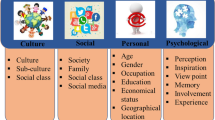Abstract
In the present study, the effect of food-related cues on the desire to eat chocolate in hungry and satiated subjects was investigated. Subjects (n=46) were randomly assigned to either a hungry or satiated group and then assigned to a group receiving one of the following stimuli: taste (2 M&Ms), sight (a photograph of M&Ms), cognition (a passage describin M&Ms), or control (no stimulus). In each testing session, subjects rated their desire to eat chocolate before and after the 90-s presentation of the particular stimulus. Each subject was then given a half pound of M&Ms so that actual consumption could also be measured. Results indicated that, following the presentation of the sight and taste stimuli, the subjects’ desire to eat chocolate was significantly increased. Furthermore, no differences in chocolate consumption due to state of hunger or type of food-related stimulus presented were found.
Similar content being viewed by others
References
Cornell, C.E., Rodin, J., & Weingarten, H. (1989). Stimulus-induced eating when satiated.Physiology and Behavior, 45, 695–704.
Garner, D., Garfinkel, P., & Moldofsky, H. (1978). Perceptual experiences in anorexia nervosa and obesity.Canadian Psychiatric Association Journal, 23, 249–263.
Herman, C.P., & Polivy, J. (1984). A boundary model for the regulation of eating. In A.J. Stunkard & E. Stellar (Eds.),Eating and its disorders (pp. 141–155). New York: Raven Press.
Logue, A.W. (1986).The psychology of eating and drinking. New York: H. Freeman and Company.
Lundholm, J., & Anderson, D. (1986). Eating disordered behaviors: A comparison of male and female university students.Addictive Behaviors, 11, 193–196.
Ogden, J., & Wardle, J. (1990). Cognitive restraint and sensitivity to cues for hunger and satiety.Physiology and Behavior, 47 (3), 477–481.
Rodin, J. (1978). Has the distinction between internal versus external control of feeding outlived its usefulness? In G.A. Bray (Ed.),Recent Advances in Obesity Research Vol. 2 (pp. 75–85). London: Newman.
Rolls, B. (1986). Sensory-specific satiety.Nutritional Reviews, 44, 93–101.
Rolls, B., Rowe, E., & Rolls, E. (1982). How sensory properties of food affect human feeding behavior.Physiology and Behavior, 29, 137–142.
Rolls, B., Rolls, E., Rowe, E., & Sweeney, K. (1981). Sensory-specific satiety in man.Physiology and Behavior, 27, 137–142.
Schachter, S. (1968). Obesity and eating.Science, 161, 751–756.
Author information
Authors and Affiliations
Rights and permissions
About this article
Cite this article
Lambert, K.G., Neal, T., Noyes, J. et al. Food-related stimuli increase desire to eat in hungry and satiated human subjects. Current Psychology 10, 297–303 (1991). https://doi.org/10.1007/BF02686902
Accepted:
Issue Date:
DOI: https://doi.org/10.1007/BF02686902




